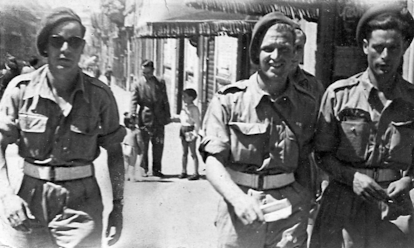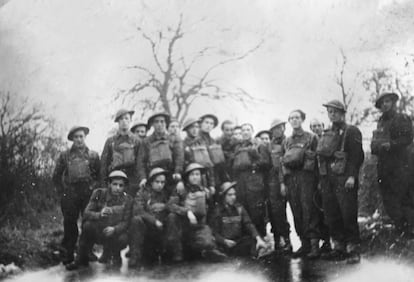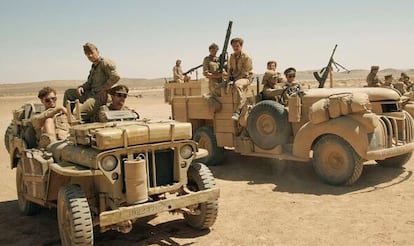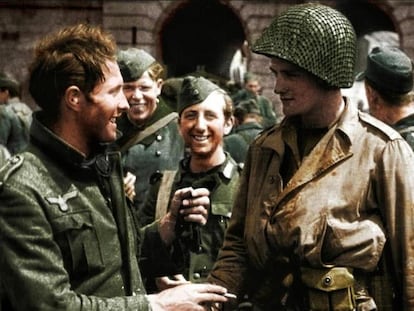From Republican soldiers to ‘Tommies’: The Spaniards who wore British uniforms to fight in World War II
Hundreds of ex-combatants from the losing side of the Civil War fought against the Nazis while enlisted in the British army. A new book reconstructs their story


On the night of March 26, 1945, near the end of World War II, a group of British special forces paratroopers, together with Italian partisans, as part of what was known as Operation Tombola, attacked the headquarters of the German 51st Mountain Corps. The German soldiers were installed in two villas, the Villa Rossi and the Villa Calvi, in Albinea, near Modena, north of the Gothic Line. The party included a Scottish bagpiper who played Highland Laddie, to emphasize that they were British forces, so as to avoid Nazi reprisals against the local Italian population.
During that action — worthy of adventure novels or films, such as The Dirty Dozen (1967) or Inglourious Basterds (2009) — a Special Air Service (SAS) soldier stood out for his bravery and ferocity. He stormed into the Villa Rossi, killing six German officers on the spiral staircase leading to the upper floors. And, when one of the operation’s commanders — his captain — was wounded, he carried him outside and took him to safety amid intense enemy fire.
For two days, the SAS man and another paratrooper carried their officer on a ladder, which they turned into a makeshift stretcher. Meanwhile, furious German patrols, eager for revenge, combed the area. The soldier was awarded the Military Medal from the British Armed Forces, as he had “displayed remarkable courage during and after the attack.” It was also noted that “his intelligence and initiative in a foreign country 30 miles behind enemy lines reflected a devotion to duty worthy of the highest praise, which resulted in saving the life of a valued British officer.”
That exemplary soldier was named Rafael Ramos Masens. He was from Spain.
A former Republican combatant in the Spanish Civil War (1936-1939), Ramos Masens was born in Barcelona in 1919. After fighting in the Battle of the Ebro, being taken prisoner and escaping, he enlisted in the French Foreign Legion. However, he ended up being forced to do hard labor in Morocco when the armistice was signed in 1940, following the defeat of France. He subsequently enlisted again, this time in the British Army — specifically, in the SAS — after the Allied landings in North Africa.

Two other Spaniards also took part in the daring Operation Tombola: Justo Balerdi, from the Basque Country, in northern Spain, and Francisco Gerónimo, who hailed from Andalusia, in the south. Both were members of the SAS and had similar career trajectories to Ramos. Balerdi was killed in combat by a shot to the head in a subsequent attack on April 21 and was buried under the name of R. Bruce: the nom de guerre he had chosen, after Robert the Bruce, the king of Scotland who appears in the film Braveheart (1995). He had chosen this name to avoid being returned to Franco’s Spain, in case he was taken prisoner.
The war adventures of these three combatants are just some of the many involving Spaniards who wore British uniforms in World War II. These feats are expanded upon in Churchill’s Spaniards: Continuing the Fight in the British Army 1939-46, which is set to be released in November of this year. The meticulously-documented work is by Séan F. Scullion, an active lieutenant-colonel in the British Army.
Scullion, 55, spent eight years researching the presence of Spanish soldiers in the British Army during World War II. Last week, he presented his manuscript at the Spanish Embassy in London, in the company of military historian friends, such as Antony Beevor.
The author, with the support of British historians Paul Preston, James Holland and Saul David, has taken up the baton of previous studies (especially those done by Daniel Arasa) to exhaustively document the adventure of Spaniards who wore the uniform of the “Tommies” (the nickname for British soldiers). They became, for all intents and purposes, British soldiers. In a way, they were a redeeming reverse of the Spaniards on the opposing side, who fought in Nazi uniform in the Blue Division.

Scullion has rigorously identified — by using their official registration numbers — 1,072 Spaniards (there were undoubtedly more, he emphasizes) who served in the British Armed Forces. They did so in all the war theaters of Europe, as well as in other places, such as North Africa and the Middle East: Tobruk, Crete, Salerno, Normandy, Arnhem, the Ardennes...
In many cases, these Spaniards were assigned to elite units, such as the commandos, the SAS (a dozen), or the Special Operations Executive (SOE), the famous organization in charge of sabotage and clandestine actions. Some, in D Squadron of the SAS, shared adventures with the Long Range Desert Group (LRDG), the so-called “sand patrols.”
Despite the UK’s initial prejudices against “aliens” serving in their army, fears about a fifth column forming (even the access of former British brigadiers was restricted) and some language problems, the Spaniards were highly valued. Their service record, Scullion points out, was filled with acts of “strength and bravery.”
British officers soon recognized that the Spaniards in their ranks — most of them experienced Republican ex-combatants, hardened during the Spanish Civil War and then in the Foreign Legion — were as good as the best British soldiers and were equally eager to fight the Italians and Germans. Their commanders noted that they were especially excellent at commando work. “They weren’t generally great shots,” Scullion notes, “but they loved the feel of cold steel in their hands: knives and bayonets.” They were credited with being skilled at dispatching enemy sentries. Regarding the stereotype of Spanish indiscipline, he says that the British didn’t see them that way. While there were certainly situations involving individual “hotheads,” there was never collective unruliness.

In the case of the only unit formed entirely by Spaniards (although commanded by British officers) — the No. 1 Spanish Company of the Auxiliary Military Pioneer Corps (AMPC) — care was taken to ensure that the corporals and sergeants were compatriots of the soldiers. Scullion is aware of at least four Spaniards in the British army who held the rank of officer. There were many Spaniards who had been officers in the Republican army and ended up serving as rank-and-file soldiers in the British forces. There was some controversy as to whether these soldiers could have been more effective had they been offered their original ranks.
Scullion shows how there were two great waves of enlistments of Spaniards in the British army. The first took place in 1940, after the fall of France, when the Spanish Company was formed. It included many Republicans who had fought in the French army at Narvik and Dunkirk, as well as Spaniards living in the United Kingdom and others who had escaped directly from Spain. Some swam to Gibraltar after the Republican defeat, like Francesc Dalmau. The Spanish Company was based in the UK until its deployment to Normandy, in 1944. They wore an “S” on their sleeves and their motto was “1940 to Victory.” Several members of the company were recruited to the SOE to undertake clandestine operations in Spain… the kind of duties associated with Ian Fleming’s James Bond novels.
Scullion includes the SOE’s assessment of Spanish recruits, such as Sergeant Manuel Espallargas, Fernando Casabayo and Luis Álvarez. Of the latter, it was thoughtlessly stated: “No initiative: [he] does not seem to have much guts. Not recommended.” Of course, given that Casabayo — said to be “an intelligent man and quick thinker” — is given a high rating, you cannot trust the SOE too much: Casabayo ended up being a traitor who sold secrets to the Franco regime through the Spanish Embassy in London.
Among the SOE recruits was Esteban Molina, from Valdepeñas, who was parachuted into France to prepare the Resistance for D-Day. His son is the Hollywood actor Alfred Molina.

The second great wave of enlistments took place at the end of 1942 as a result of Operation Torch, which wrenched North Africa away from German control. This made it possible for Spaniards who were being held in internment camps in Tunisia or Morocco to enlist. Many Spaniards joined the British army after leaving the French army — which they had enlisted in from the refugee camps after the Civil War — when it was defeated and Vichy France was established.
A notable episode is that of the 300 Spanish legionnaires who mutinied in Avonmouth, near Bristol, for refusing to return to Pétanist France. After their French commanders proposed that one in three of them be shot for encouraging other soldiers to revolt, they stayed in the UK and joined the British army en masse. Many were reluctant to fight in the ranks of De Gaulle’s Free French because of their bad experience with the French: they felt that the treatment they received from the British was better.

At the end of World War II, many of the Spanish men in the British army had been fighting fascism for 10 years. Scullion stresses that, despite the paradox of now being on the winning side, they had to swallow the bitter pill of seeing how Franco’s dictatorship survived. “They were very disappointed to [not have been able] to go after Franco.” Their story, he points out, is also that of the Spanish Republican exile and its tragedy. Scullion continues the book by writing about the lives of those who stayed in Britain at the end of the war. Some of them organized themselves — they formed the Spanish Ex-Servicemen’s Association — and continued to actively protest Franco’s regime, which ended with his death in 1975.
“The opening of new archives has allowed me to go beyond what was known,” Scullion explains. He has credited all previous work done on the subject, such as the books published by Joaquín Mañes Postigo. “It’s surprising to see that Spaniards in the British army were everywhere,” he notes. The researcher believes that it’s necessary to spread the word that the Spaniards who served on the Allied side on the Western Front (another story is that of those who served with the Red Army) were much more numerous than those who belonged to La Nueve (Spanish for “the nine”), the 9th Company of the Régiment de marche du Tchad, which was part of the French Liberation Army. This is despite the fact that more has been written about the latter.
Scullion advocates for recovering the memory of these other Spaniards in British uniform. However, unlike journalist Daniel Arasa, he hasn’t been able to interview any veterans, “because they’re no longer alive.” Still, he has spoken to their families. He thanks them for their support in the book. “We have the duty to tell the story of these soldiers and preserve their memory,” he tells EL PAÍS, adding that they’re “an integral part of the history of the British army.”
Regarding the assessment of the Spanish as combatants, he recalls that many were “first-class soldiers” who, in addition to their experience in the Civil War, had also served in the Foreign Legion. “They carried out incredible acts of bravery,” he points out. He mentions three particular cases as examples, in which two Spanish soldiers won medals for courage. Josep Vilanova crossing the Volturno River: he swam, killed three Germans on the shore with his machine gun and saved a patrol from an ambush. Alfonso Cánovas García liberated Foix with the SOE and the local guerrillas: after receiving a bullet in the leg, he continued fighting with great courage, managing to remove several German machine gunners from the bridge at the entrance to the city. And, of course, there’s the episode of Rafael Ramos, recounted at the beginning of this article.
The author has even traced the presence of two Spaniards — José Redondo and Manuel Surera — in the commando action to kill Rommel (Operation Flipper), although they didn’t ultimately form part of the ill-fated group that attacked the Desert Fox’s headquarters.
A separate chapter is devoted to the famous presence of Spaniards in British uniforms (and tam o’shanter caps) in Crete, where 63 arrived as members of the Layforce — Colonel Robert Laycock’s commando force — and became “the rearguard of the rearguard.” They formed a shock line to protect the desperate evacuation of the island following the invasion of the German airborne forces. Half of the Spaniards were captured (they pretended to be born in Gibraltar to avoid deportation to Spain) and several died. The Malaga-born Francisco Gerónimo — a fighter who had been in the Foreign Legion — spent 11 months on the run, hiding in the mountains under the name of Kosta Spirachi. He was finally able to escape to Egypt via fishing boat in an SOE operation. He then served in the SAS in Italy and buried his friend, Justo Balerdi.
Could Patrick Leigh Fermor — the famous British scholar and soldier — have met any Spaniards in Crete? “I don’t think so,” Scullion replies. “When he carried out his operation to capture General Kreipe, the Spaniards had already left. Perhaps he met some SAS members in Cairo or Alexandria.”

Of course, there were also outliers. Scullion’s book tells stories of some deserters, murderers (Private López was shot for killing a French officer in a fight in a canteen) and traitors. The villain par excellence would be Casabayo, of course. “But that was normal in any contingent. In that respect, the Spanish were not worse than the rest of the British army.”
Scullion’s book doesn’t mention the Spanish troops in the RAF or the Royal Navy: he limits himself to the land army. However, he notes the British authorities didn’t allow 100 former Republican pilots to enlist in the RAF (a photo in his book shows Antonio Sandoval, an ace, with members of the Spanish Company), despite the fact that some mechanics were permitted to work on planes. Certain Spaniards were also incorporated into the British Merchant Navy: they ventured on dangerous Arctic convoys to the Soviet Union.

Scullion, who lived in Spain as a young man, is now a lieutenant-colonel in the Royal Engineers (RE), a unit closely related to the Royal Pioneer Corps (RPC), to which all Spanish volunteers belonged at one time or another. He has served in combat missions in the Balkans, Iraq, Afghanistan, and various African countries over the course of 35 years. He currently lives and works in the Netherlands, for NATO.
“Military experience has been very useful to me in understanding what the service of the Spanish was like. Like them — who fought everywhere from northern Norway to the Sahara, Syria, Eritrea, Sudan and even India — I’ve been in [many] places. Being a career soldier and commanding operations allows you to understand, in a very special way, the adventures of these incredible people.”
Scullion — who supports the idea of dedicating a monument to the Spanish soldiers — stresses that they were very proud of their service in the British army. “And their British officers were very proud of them,” he adds, opining that the British Armed Forces has always been very inclusive. “In fact, I insist that this book isn’t only about Spanish fighters, but [also] about a part of the tradition, history, and culture of the British army.”
Sign up for our weekly newsletter to get more English-language news coverage from EL PAÍS USA Edition
Tu suscripción se está usando en otro dispositivo
¿Quieres añadir otro usuario a tu suscripción?
Si continúas leyendo en este dispositivo, no se podrá leer en el otro.
FlechaTu suscripción se está usando en otro dispositivo y solo puedes acceder a EL PAÍS desde un dispositivo a la vez.
Si quieres compartir tu cuenta, cambia tu suscripción a la modalidad Premium, así podrás añadir otro usuario. Cada uno accederá con su propia cuenta de email, lo que os permitirá personalizar vuestra experiencia en EL PAÍS.
¿Tienes una suscripción de empresa? Accede aquí para contratar más cuentas.
En el caso de no saber quién está usando tu cuenta, te recomendamos cambiar tu contraseña aquí.
Si decides continuar compartiendo tu cuenta, este mensaje se mostrará en tu dispositivo y en el de la otra persona que está usando tu cuenta de forma indefinida, afectando a tu experiencia de lectura. Puedes consultar aquí los términos y condiciones de la suscripción digital.
More information
Archived In
Últimas noticias
Welcome to the post-religion era: The idea of Christianity as the absolute truth has become obsolete
‘I thought you would like it’: The risky sexual practice popularized by TV shows and TikTok
The digitalization of tourism: ‘They promise experiences and gave us the worst possible one’
Mexican peso defies uncertainty with forecasts of a new period of stability in 2026
Most viewed
- Sinaloa Cartel war is taking its toll on Los Chapitos
- Oona Chaplin: ‘I told James Cameron that I was living in a treehouse and starting a permaculture project with a friend’
- Reinhard Genzel, Nobel laureate in physics: ‘One-minute videos will never give you the truth’
- Why the price of coffee has skyrocketed: from Brazilian plantations to specialty coffee houses
- Silver prices are going crazy: This is what’s fueling the rally










































